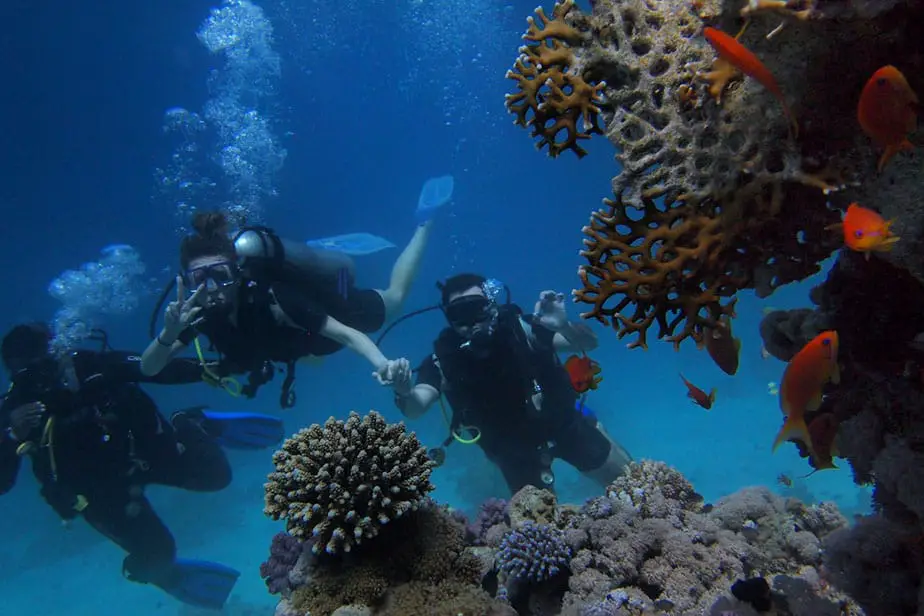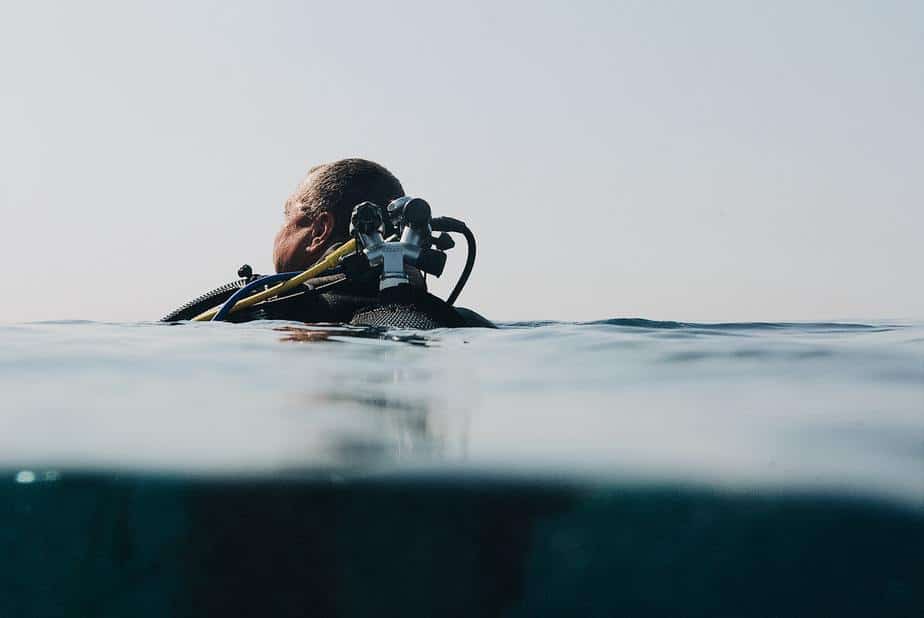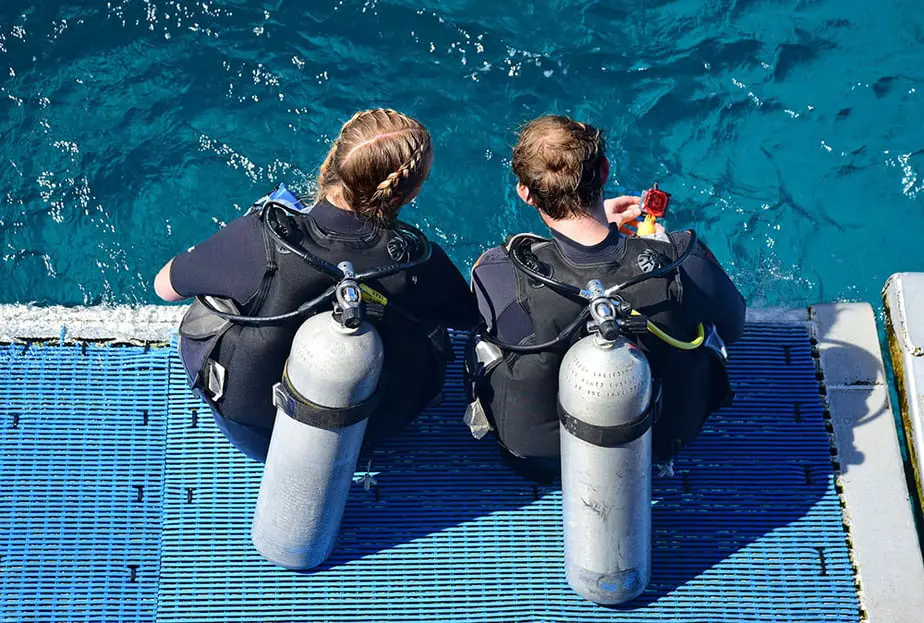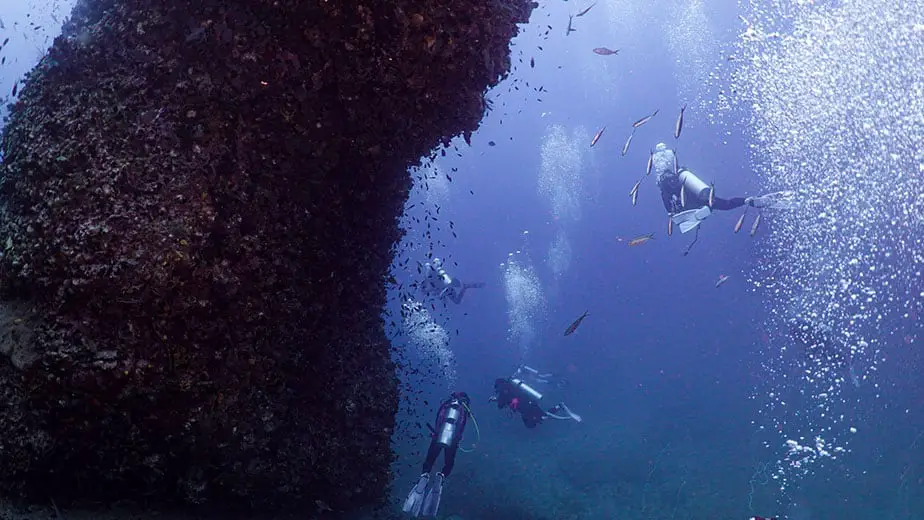One of the most important things you learn in the Open Water Diver course is to stay with your dive buddy. Losing sight of a dive buddy is a big ordeal that can cause anxiety and disorientation, particularly in low-visibility conditions. Furthermore, if you cannot find your buddy, the guidelines state that you will have to abruptly end your dive which no diver wants.
To avoid this, you need to stay vigilant and keep an eye out for each other. Memorize what your partner looks like, as well as any distinguishing features of their scuba gear. Prior to diving, discuss a plan on what to do in case of separation. You should always stay within a 3-4 meter (10-13 feet) distance from each other, particularly if the visibility is low. Every 2-3 minutes do a check on your partner, and so on. These tips will drastically reduce the chances of separation during a dive.
Sometimes, even if you are doing everything correctly, a strong current or other unexpected scenario may occur that causes a separation between you and your partner. In that case, follow the regrouping procedure you discussed with your partner prior to the dive. The general rule is that if you cannot regroup within one minute, you should return to the boat and report them as missing.
In this article, we will discuss various tips on how you can stay with your buddy on a scuba dive and how to reduce the chances of getting separated. We will also discuss what to do if you somehow get separated from your dive buddy so that you both have the greatest chance of safely regrouping.
Why do you need a buddy when diving?
Dive buddies are important to have during a scuba dive for safety reasons. They can provide assistance if you have an equipment malfunction, are stuck, or are having some kind of medical emergency. That’s why if you get separated from your dive buddy, the absence of someone watching your back is so risky that, if you cannot find your dive buddy quickly, you should return to the surface.
Generally, divers will dive in groups of two or three while using the buddy system. No matter how skilled a diver you are, sometimes an accident or emergency may occur where you cannot survive on your own. If you are the most experienced diver in your group, then you can look out for your less experienced buddy who may get in trouble without you.
Before a dive, have your buddy help you don your equipment and vice versa. This is a great opportunity to familiarize yourself with their gear. Knowing what they look like can help you keep track of them underwater. Also, it’s just easier to get equipped with someone helping you.
With your dive buddy, discuss the dive plan so you know exactly where you’ll be headed, how deep you’ll dive, for how long, and what to do in case of separation. Also figure out what hand signals to use for communication. Depending on where in the world you are diving, it’s possible that the hand signals have different meanings.
Plus, if your dive buddy is a good friend of yours, sharing great dive sites and experiencing breathtaking discoveries with someone else is one of the many joys in life. In future gatherings, you can talk about your unforgettable memories together and bond over shared experiences.
How to stay with your buddy

Here are the tips you should follow to decrease the chances of separating from your dive buddy.
- Discuss the dive plan with your buddy. What’s the route, how deep will you dive, for how long, etc.
- Discuss a separation protocol. This is especially important for diving in low visibility conditions or for drift diving.
- Dive buddies should stay within 3-4 meters (10-13 feet) of each other on good visibility dives.
- On low visibility dives, divers should decrease the distance mentioned above to whatever is necessary to maintain a visual on each other.
- For low visibility or stronger drift dives, consider using a buddy line or tether. This introduces the risk that both divers can get swept away by a strong current. If the conditions are too extreme, just abandon the dive.
- Do a check on your dive buddy every 2-3 minutes.
- Don’t get so caught up on exploring that you abandon your partner and vice versa.
- Be aware of your blind spots because that’s where you buddy might be.
- Communicate with your dive buddy using your dive torch, hand signals, or by tapping on the scuba tank.
- Consider abandoning the dive if the water conditions are too rough before you get separated.
Common causes of buddy separation
Strong currents. When you are diving in strong currents, since both of you are moving so fast, if either one stops to look at something then the other will be swept out of sight very quickly.
Poor visibility. Low visibility drastically increases the chance of buddy separation. Stick closer to your dive buddy so that you always have line of sight of each other. Consider using a buddy line or tether to link the group together. If the visibility is so poor, consider abandoning the dive altogether before anything bad happens.
Physical obstruction. When penetrating a wreck or entering a cave, the visibility is low, making separation more likely. On top of that, space is limited and sometimes divers must pass through tight areas one at a time. Pre-dive planning and a buddy line may be necessary to prevent separation.
Distractions. There are many ways one can get distracted during a dive. For instance, equipment failure can occupy the person it affects as they try to fix the problem. Or perhaps someone in a dive group sees something that interests them and wanders off on their own. If dive buddies don’t occasionally check on each other, it’s really easy to lose track of their positions.
Lack of communication or miscommunication. Before the dive, it’s really important that a separation protocol is discussed as well as what signals to use. Underwater, communication can be done using the dive torch, hand signals, and tapping on the tank. Both divers need to be on the same page as to what the signals mean so there is no miscommunication.
What to do in the event of buddy separation?

In this section, we will go over the general separation protocol that most divers use. Depending on the type of diving you are doing and what you discuss with your dive buddy, it may differ from the usual protocol. It is as follows:
- After noticing you are separated, stop where you are and spend 60 seconds looking 360° for your dive partner.
- Try to get your buddy’s attention using light and sound. Flicker your dive torch as you are turning so that it makes a noticeable pattern so that others can locate you. You can also make noise underwater by tapping a pointer on your air tank.
- If you cannot spot your partner and vice versa, end the dive and ascend to the surface slowly, performing the 360° search technique on your way up. Remember to perform a 3-5 minute safety stop near the surface.
- During your safety stop, deploy your delayed surface marker buoy (DSMB) or safety sausage. This lets your buddy spot your marker easily if they are already awaiting you at the surface.
- Once you surface, perform another 360° spin, looking in all directions along the surface for your buddy.
- If you performed a boat dive and have not yet spotted your partner, return to the boat and notify the crew about your missing dive buddy
- If you performed a shore dive and have not yet spotted your partner, return to the shore and notify the coast guard about your missing dive buddy.
- Never re-descend in search of your dive buddy; you will put yourself at serious risk of decompression sickness. Furthermore, if your dive buddy was caught in a serious situation underwater, think about your own safety and do not head back in.
- Assuming your buddy followed the same separation protocol, you should spot your buddy some time before you surface or shortly afterwards.
As you probably noticed, buddy separation is a highly time-sensitive situation. Basically as soon as you notice something is wrong, an internal clock should be ticking down as you perform each step. Do not dilly-dally and think everything is fine. If you or your partner was truly caught in a dangerous situation, then each second could potentially be the difference between life and death.
Buddy separation can also be an anxiety-inducing experience. One might panic or otherwise not be in the right state of mind to do any complicated thinking. That is why a separation protocol should be discussed beforehand so that all divers know exactly what to do and can take quick action when it occurs.
Wear easy-to-see equipment
How much do you care about fashion underwater and do you prefer utility over how you look? One of the easiest ways for your dive buddy to keep an eye on you is to wear bright and distinguishing equipment.
The colors bright yellow and green are generally accepted as the easiest colors to spot underwater. Bright yellow and green look the same at recreational depths and stand out due to their brightness. It’s for this same reason that your octopus (secondary regulator) is bright yellow. Other colors that really stand out are orange and bright pink.
The deeper you descend, the more some colours become harder to see. For instance, red is the hardest to spot underwater, followed by orange, yellow, all the way down to blue. Thankfully, at only recreational diving depths, the only colour that is missing at this point is red, perhaps a little bit of orange as well.
Furthermore, even though blue is the last color to go, it tends to blend in with the blue water, so that should be avoided as well. If you want to make yourself easier to spot underwater, consider wearing bright yellow and green colored equipment.
Is the buddy system necessary?

If you know the history of the buddy system, you’ll know that it was invented during a time when scuba gear was not as safe and the activity was considered extremely dangerous. Fatalities and near-death incidences were occurring on many dives. It was basically suicide to dive alone back in the 40s and 50s.
Following the “never swim alone” motto that swimming and lifeguard programs had, it was also applied to scuba diving in an effort to prevent injuries and death. This system proved to be successful which is why it remained throughout the decades, where it is taught even until now.
Even with all of the scuba gear technological advancements over the years, it’s still a good idea to stay with your buddy on a dive because equipment malfunctions can happen, the ocean is unforgiving, and sometimes medical emergencies arise.
Can you dive without a buddy?
Nowadays, the stance against solo diving is beginning to loosen, to the point where PADI is offering a Self-Reliant Diver specialty course. Solo dives are dives which take place partly or completely without the assistance of a dive buddy. A solo dive can start out with a buddy, but then each diver separates to do their own activities.
Solo diving may also refer to dives where the other divers are not trained or properly equipped to provide assistance in the event of an emergency. For instance, scuba instructors are considered solo divers since their students are not capable of helping them if something goes wrong.
Before attempting a solo dive, the diver must already have a lot of diving experience diving with a group. For example, in order to be eligible to take the aforementioned PADI Self-Reliant Diver course, one must have at least 100 logged dives. Solo diving is rarely done recreationally since the potential risks are high. Most dive centers discourage solo diving and will automatically assign you a dive buddy.
The divers that benefit the most from solo diving are commercial or technical divers. They need to concentrate completely on their task and do not have time to watch over somebody else. They will also have specialized gear, many years of experience, and the proper training to do their job alone.

